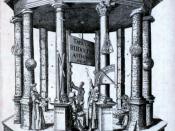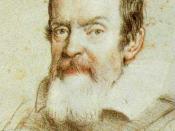The Scientific Revolution
The Scientific Revolution was a period of great change in Europe from the middle of the Sixteenth Century to the Middle of the Eighteenth Century. Taking the initiative from the culutural and artistic revolution of the Renaissance, great minds sought to discover the world of science. Famous scientists such as Copernicus, Kepler, Galileo, and Newton all worked towards the common goal of knowledge of the world. Science studies all over the world increases, and people began to develop a much greater familiarity with nature and the physical world. Yet along with the increasing acceptance of science came a rising opposition - the group of people, largely the Church, who felt that the older, traditional views of the world were correct. So even though the Scientific Revolution brought brilliant new inventions and ideas, it also created large controversy.
In the times preceding the Scientific Revolution, people in Europe largely believed what past scientists and thinkers had said about the world and nature.
And even though the philosophers of ancient Greece and Rome were very intelligent, they did not have the necessary tools to be scientists. They merely pondered things in nature and decided on theories without any factual basis. Beginning with the Middle Ages and including the Renaissance, people's ideas about science largely revolved around religion. People believed what the Church wanted them to believe, and hardly anyone questioned the Church (Hooker 1). One of the largest ideas at the time was that of geocentrism. People up until the Scientific Revolution believed that the cosmos were many circles all contained within one another. The ball on the inside was Earth, and it was the solid Earth that the popoluation knew. Outside of the inner ball were surrounding, trasparent spheres, or crystalline spheres. Theses spheres were the other planets...



Thanks
this essay made mine look like a kindergargen paper thanks for the help i got from reading it
1 out of 1 people found this comment useful.